Read The Ancestral Table: Traditional Recipes for a Paleo Lifestyle Online
Authors: Russ Crandall
The Ancestral Table: Traditional Recipes for a Paleo Lifestyle (15 page)

1. Place the potatoes in a stockpot, then fill with enough water to cover the potatoes by 1". Bring to a boil on high heat, then reduce the heat to medium and simmer until fork-tender, about 15 minutes. Drain the potatoes in a colander and leave them there as you prep the other ingredients.
2. Add the butter to the empty stockpot and warm on medium heat. Add the leek or green onions and simmer until aromatic, about 1 minute. Add the kale and sauté until bright green, about 3 minutes. Add the potatoes and cream, remove from the heat, and mash everything together until well mixed. Season with salt and pepper to taste. Serve with sausage and an extra dollop of butter on top.
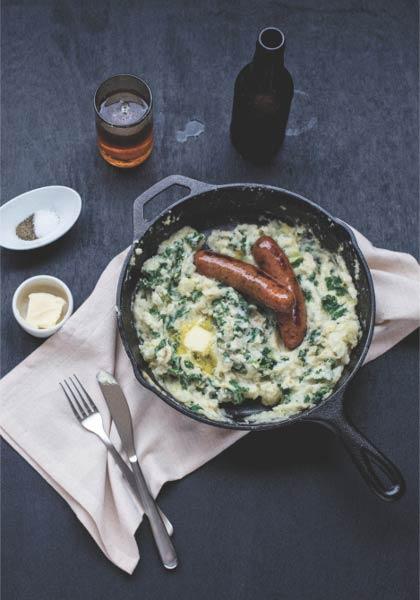
Gnocchi
Gnocchi are a type of dumpling most often made with potatoes. Like many Italian recipes, there is a lot of variability to the dish. It’s believed that gnocchi have been around since the Roman era and that they actually came from the Middle East. It’s unclear whether the word gnocchi comes from nocchio (a knot in wood) or from nocca (knuckle).
Prior to the arrival of potatoes from the New World, semolina (coarse-ground durum wheat) was used to make gnocchi; semolina gnocchi recipes are still around today.
SERVES:
6
PREP TIME:
2 HOURS (TO BAKE AND COOL THE POTATOES)
COOKING TIME:
30 MINUTES
3 LARGE RUSSET POTATOES (ABOUT 2 LBS.)
1 TSP. OLIVE OIL
2 TSP. KOSHER SALT, DIVIDED
1/2 CUP WHITE RICE FLOUR
1/4 CUP SWEET RICE FLOUR (SOMETIMES LABELED MOCHIKO)
2 EGGS
1 TBSP. GRATED PARMESAN CHEESE
3 TBSP. TAPIOCA STARCH
1/4 TSP. GROUND NUTMEG
1/2 TSP. WHITE PEPPER
1. Preheat the oven to 350°F. Rinse the potatoes, poke them with a fork, rub them with olive oil, and sprinkle about 1 tsp. kosher salt on them. It’s not an exact science. Bake until softened, about 1 hour. Cool the potatoes for 1 hour, then peel.
2. In a mixing bowl, combine the rice flours. Sprinkle a little of the flour mixture onto a large prep surface. Using a potato ricer or grater, rice or grate the peeled potatoes. Make a well in the middle of the pile of riced potatoes. Crack the eggs into the well, then sprinkle the cheese, tapioca starch, nutmeg, pepper, and remaining 1 tsp. salt around the ring of potatoes. With your fingertips, beat the eggs, then slowly mix them into the potatoes in a circular motion. Add most of the rice flour as you mix everything together, again using just your fingertips.
3. Once everything is well mixed, start kneading the dough until you have a nice-looking little loaf. Keep adding rice flour as you knead until it reaches a dough-like consistency. Divide the dough into 6 chunks, then roll each chunk into a thin rope. Cut the rope into bite-sized pieces. Sprinkle a little flour over everything if it starts to stick.
4. Before cooking all of the gnocchi, test a couple in boiling water—if they fall apart before floating, add more flour. To preserve them for later, place them on a baking sheet lined with parchment paper and freeze overnight; they can then be put in freezer bags and frozen for up to 6 months.
5. To cook the gnocchi, drop them in boiling, salted water, and fish them out when once they start floating. It should take only a couple minutes. Drain and toss with whatever you’d like—butter, Simple Basil Pesto (
see here
), or Basic Red Sauce (
see here
).
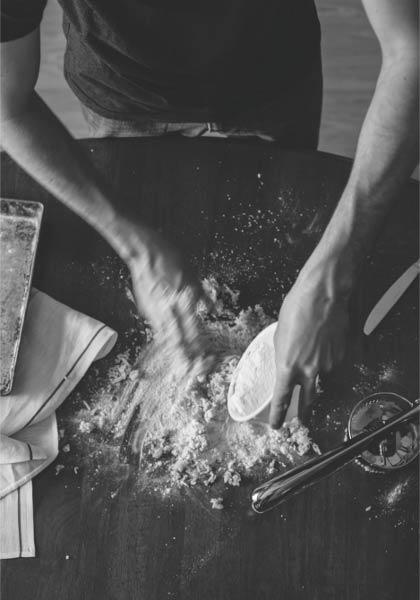
Sweet Potato Poi
(Poi ‘Uala)
Poi is a Polynesian staple food that is typically made with mashed taro root; however, the Hawaiian people also traditionally made poi from sweet potato and breadfruit. Coconut milk adds sweetness and depth of flavor to this dish. Its creamy texture and sweet taste are perfect accompaniments to my Kalua Pig (
see here
) and Lomi Lomi Salmon (
see here
) recipes.
SERVES:
4
PREP TIME:
5 MINUTES
COOKING TIME:
1 HOUR
3 MEDIUM SWEET POTATOES (~1 1/2 LBS.), CUT IN HALF
1 (14 OZ.) CAN COCONUT MILK
1/2 TSP. SEA SALT
1. Place a steamer rack in a stockpot. Fill the pot with water until it starts to touch the bottom of the steamer rack, about 11/2". Put the sweet potatoes on the steamer rack, cover with a lid, and steam on medium-high heat until soft to the touch, about 25 minutes. Check the water level about 15 minutes into steaming to make sure that the water hasn’t evaporated; add more hot water if needed.
2. Turn off the heat, remove the sweet potatoes, and allow to cool for 15 minutes. Empty the stockpot and rinse clean. Warm the coconut milk in a separate pot on low while the potatoes cool. Once they are cool, slip the skins off the potatoes and discard, then put the peeled potatoes back in the stockpot.
3. Mash the potatoes with a potato masher or whisk, then add the salt and stir in the warm coconut milk, mixing until you get the right consistency—somewhere between mashed potatoes and pea soup. If you run out of coconut milk, add water until you get the desired consistency. For an extra-smooth poi, run the poi through a blender or use an immersion blender. Serve at room temperature. Leftovers will keep in the fridge for a week.
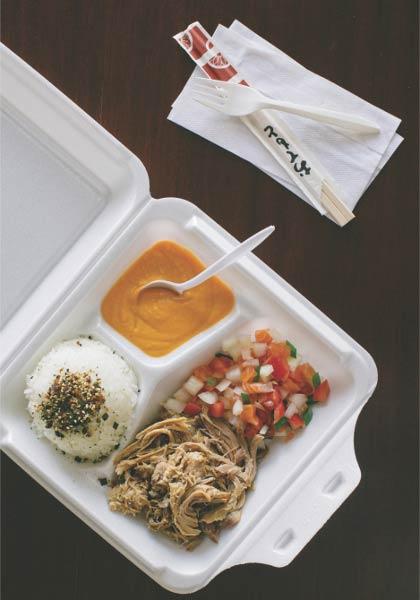
Parsnip Puree
Before the potato arrived in Europe, parsnips were one of the main staple crops throughout the region. First cultivated in Eurasia, parsnips were spread across Europe by the Romans. Due to their natural sweetness, parsnips were often served sweetened with honey or in fruitcakes for dessert.
Parsnip puree is just the start when it comes to puréed root vegetables. Turnips, carrots, sweet potatoes, celery root, and rutabaga can all be puréed (alone or in combinations) to delicious effect using the method below.
SERVES:
6
PREP TIME:
10 MINUTES
COOKING TIME:
50 MINUTES
2 LBS. PARSNIPS, CUT INTO LARGE CHUNKS
4 CLOVES GARLIC
10 BLACK PEPPERCORNS
2 BAY LEAVES
6 TBSP. BUTTER, CUBED
1/2 TSP. GROUND NUTMEG
1 TSP. SEA SALT
1. Place the parsnips in a large pot. Wrap the garlic, peppercorns, and bay leaves in cheesecloth and tie together, then add to the pot. Fill the pot with water until the parsnips are covered by 1". Bring to a boil, reduce the heat, and simmer until easily pierced with a fork, about 40 minutes.
2. Drain the parsnips and discard the cheesecloth. Purée the parsnips, in batches if needed, with a food processor or an immersion blender. Stir in the butter, nutmeg, and salt, and whip with a potato masher or whisk until smooth. Add more salt and butter to taste.
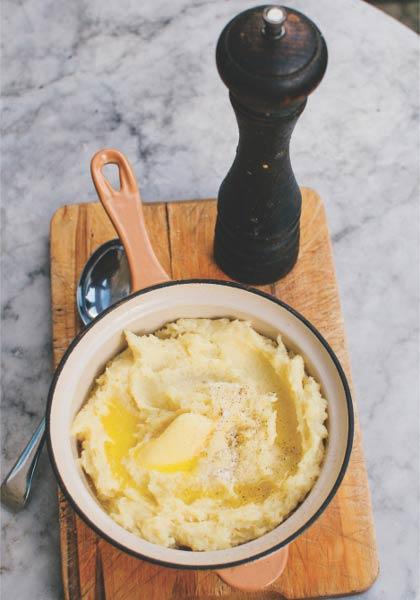
Tostones
Tostones are twice-fried plantains. The dish is common in many Central and South American countries, although it is sometimes known by other names.
Plantains and bananas are different varieties from the same parent plant. The banana plant originated in the eastern Indonesian islands as many as 9,000 years ago, where it spread throughout Asia before making its way to Africa. Portuguese sailors brought banana plants from West Africa to the Americas in the 16th century, and bananas and plantains have been an important part of Central and South American cuisine ever since.
SERVES:
4
PREP TIME:
5 MINUTES
COOKING TIME:
25 MINUTES
3-4 MOSTLY GREEN PLANTAINS (A FEW RIPE SPOTS ARE OKAY)
1/4 CUP COCONUT OIL
SALT TO TASTE
1. Peel and slice the plantains into 1" slices, slicing along the peel with a sharp knife to make peeling easier. Heat the oil in a skillet on medium-low heat until hot, about 3 minutes. Add the plantains and partially fry, turning every 30-60 seconds, about 3 minutes per piece. They will turn bright yellow as they fry; be careful not to brown them. Drain on paper towels as you fry them in batches, and let cool.
2. Smash the plantains to about 1/2" thickness. A tostonera is a smashing device made of 2 boards joined by a hinge, with a divot for the plantain; while a tostonera makes the job easy, you can also smash the plantains between 2 paper bags using the bottom of a plate.
3. Once your plantains are smashed, re-fry them. Reheat the oil on medium heat until hot, then add the smashed plantains. Fry on each side until golden brown, about 2 minutes per side. Drain on paper towels, sprinkle with salt to taste, and serve.
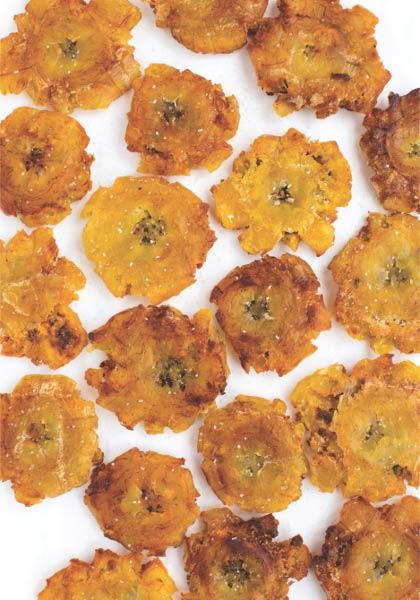
Pão de Queijo
(Brazilian Cheese Buns)
Pão de queijo is a traditional cheese bun popular in South America, especially in Brazil. The dish has been around since the 17th century and was made with just tapioca starch and water before the widespread domestication of cattle in Brazil during the 19th century led to the addition of cheese. Today, it’s a popular breakfast food and can be found in most bakeries in Brazil.
Tapioca starch is often labeled as tapioca flour, cassava starch, or yuca starch; they are all the same thing.
SERVES:
6
PREP TIME:
10 MINUTES
COOKING TIME:
20 MINUTES
